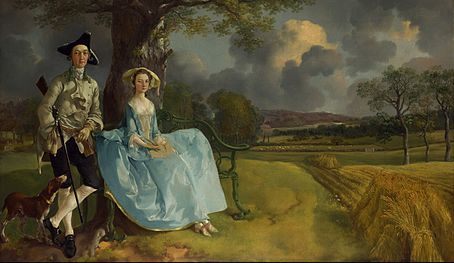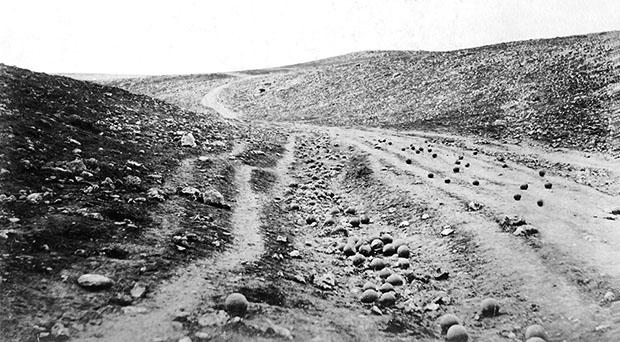In this exercise, we are asked to find at least 12 examples of eighteenth and nineteenth century landscape paintings, listing all the commonalities we can find across the examples.
| Théodore Rousseau, Forest of Fontainebleau, Cluster of Tall Trees Overlooking the Plain of Clair-Bois at the Edge of Bas-Bréau, c.1849-55. Oil on canvas. Los Angeles, J. Paul Getty Museum. Accessed from http://www.19thc-artworldwide.org/spring08/39-spring08/spring08article/107-new-discoveries-theodore-rousseaus-forest-of-fontainebleau |
Rousseau was the leader of the Barbizon (or Fontainebleau) School of French painting. Eschewing the conventions of academic art (characterised by the painting have a rationale, a message, and a series of conventions, notably idealising the subject), the school focussed on realism: everyday life, the landscape as it IS, not as we might wish to think it is (Encyclopedia of Art History).
 |
| Théodore Rousseau, The Charcoal Burner's Hut c. 1850. Accessed from https://en.wikipedia.org/wiki/Th%C3%A9odore_Rousseau#Work |
Rousseau was a Parisian but in 1847 bought a house in Barbizon and moved there permanently. His paintings were deliberately simple in subject matter, and endeavours to reflect nature. Trees in particular interested Rousseau: their solidity and stoicism (Morton, 2016) as demonstrated in both these paintings
 |
| John Constable, The Hay Wain 1821. Accessed from http://www.takeonepicture.org/picture/previous_haywain.html |
The Hay Wain is one of Britain's most famous paintings. The river is the Stour between Suffolk and Essex. The scene is typical of the 'picturesque' style of image, a concept attributed to William Gilpin as an attempt to reconcile Burke's concepts of sublime and beautiful (Alexander 2015). The image resonates with Rousseau's work: the emphasis on the everyday scene, the rustic landscape. Technically, the painting works well - the hay wain lies very close to the Fibonacci line. The viewer has the impression of a scene that is in harmony, with a sense of Arcadian peace and charm. The workers in the hay wain take a moment to admire the view. A black and white dog watches from the bank. The painting is brought to life by rippling water and tumultuous skies, as well as the other figures visible in the background - a woman by the cottage, dipping her hand into the cool water, and the farm workers in the fields far in the background.
The painting found no buyer originally; it was only after it was exhibited at the 1924 Salon that it gained notoriety (Wikipedia).
 |
| William Gilpin |
William Gilpin sought to reconcile Edmund Burke's ideas of beauty and sublime. Beauty is a concept of harmony, of absence of conflict, feeling pleasurable, gentle. Sublime is about exciting emotion; arousal; (in colloquial terms) moving the audience out of its comfort zone. Gilpin thought that viewers could be directed towards how to appreciate scenes (partly because his writings were aimed at incipient tourism). His sketc here is typical: like the Hay Wain, technically the image works well with Golden Ratio and Rule of Thirds such that it is likely that scenery imagery could be improved, either by viewing the sceenry form the most favourable angle, or even amending reality to fit his rules of picturesque beauty:
"I am so attached to my picturesque rules, that if nature gets wrong, I cannot help putting her right." (Andrews, 1999)
Gilpin's ideas can be seen in the works we have seen so far, and, indeed, are very evident even today in the typical picture postcard image of landscapes and townscapes. It is imagery as it is believed the audience wish to see; there is an implicit assumption of harmony, of the views of the viewer dominating the reality of the rural idyll being a tough place in which to live for most of its 18th and 19th century residents.
| Joshua Shaw, The Deluge Towards its Close, c1813 Accessed from http://www.metmuseum.org/collection/the-collection-online/search/12569 |
Joshua Shaw was born in Britain (Staff of Greenville County Museum of Art "GCMA", 2008). Largely self taught, he became interested in the power of nature, as demonstrated by this masterpiece. The painting is an archetypal example of what Burke called the 'sublime'. In binary opposition to beauty, sublime emphasises the rawness of nature:
This is a theatrical work, not intended as a representation of reality, more akin to earlier sylized representations of religious events. What it shares with the other paintings here is a sense of order in the composition - the body in the foreground fits the Golden Ratio - and a sky that reflects the aim of the image: in this case a dark foreboding look."Whereas beauty was the domain of contentment and harmony....the sublime prompted unsettled feelings and emotional awakening; it was often the raw, heart-stopping power of Mother Nature." (Alexander, 2015, p70)
 |
| Joshua Shaw Seven Hills: An American Landscape 1818 |
The previous painting and this are by the same artist, but of a very different genre. Shaw moved to America in 1817, and envisioned a career painting distinct landscapes that could be adopted as prints to be sold to the burgeoning American middle class (GCMA, ibid). The soft lighted beauty of a sunset or sunrise near Shaw's adopted home of Philadeplhia were an obvious subject. In the painting he uses the tree on the left as part of the frame rather as Constable did in the Hay Wain. As with the latter, water features in the centre of the image, with Arcadian overtones of peaceful sailing and cows in a relaxed position.
 |
| JMW Turner, The Burning of the Houses of Lords and Commons 1834 |
A commonality here is Turner's use of sketches taken from a boat while the buildings were burning (source: Wikipedia). Gilpin also used sketches, as did many landscape artists for practical reasons.
| JMW Turner Staffa, Fingal's Cave 1831/2. Accessed from http://collections.britishart.yale.edu/vufind/Record/1669251 |
This second Turner shares the feeling of sublime. Turner visited Fingal's Caves via ship from Tobermory. It is interesting that the artist's imagination (insofar as producing a work of art) was caught more by the journey than that he had just visited what Scott called one of the most extraordinary places he ahd ever beheld (Yale Center for British Art, undated).
There is a commonality demonstrated by Staffa of an artist choosing his subject as well as his perspective; what is the exactly the artists' experience that they wish to portray"he was caught in a wild storm; upon his return to London, he commemorated his memorable voyage, choosing the moment when the sun “getting through the horizon, burst through the rain-cloud, angry” to create an extraordinarily compelling enactment of an encounter between man, symbolized by the steamship, and the unbridled forces of nature (Turner, “Correspondence”, p. 209). " (Yale Center for British Art, undated).
 | ||
| Thomas Gainsborough, Romantic Landscape c1783. Available from https://www.ultravie.co.uk/blog/wp-content/uploads/2012/12/PL001739.jpg |
| Thomas Gainsborough, Mountainous Wooded Landscape with Figures and Sheep (Study for 'Romantic Landscape'), ca. 1783 |
 |
| Thomas Gainsborough, Mr and Mrs Andrews, about 1750. Accessed from https://en.wikipedia.org/wiki/Mr_and_Mrs_Andrews |
If the contrast is the portraiture, the similarity with the previous paintings are also evident: the strong sky, the composition, and the gentle Arcadian feel to the painting. Perhaps Gainsborough was demonstrating his ability to paint landscapes that might earn him future commissions.
 |
| Jules Adolphe Breton, The Gleaner 1900. Accessed from http://denverartmuseum.org/exhibitions/changing-landscapes-themes-19th-century-french-and-american-painting |
| Breton's very late 19th century work continues both the theme of people in the paintings as an integral part of the rural dream and the effect of light. There is sense of Arcadia. There is no smile but a sense of dignity in the expressions of the woman. She is not obviously poor in the sense of dress or nourishment. There is harmony, a sense of well being for the viewer enhanced by the effect of late light. Listing the commonalities across the examples:
| ||||||
| There is resonance with discussion in contemporary photography on the use of filters and other digital manipulation to image designed to enhance the experience of the viewer. This concept was discussed in a previous module, conjecturing that manipulation creates an alternative reality. The concepts of beauty, sublime and picturesque have been introduced. The second part of the exercise is to find examples of these from any age of photography.  Fenton's Valley of the Shadow of Death (1855) is an example of the sublime in early photography. It is a stark, barren landscape with just the cannon balls to give a clue as to the reality of the situation.  Ansel Adams' The Tetons and the Snake River (1942) demonstrates the American tradition of demonstrating the landscape in all its glory: 'an ideal image in an ideal land' (Clarke, 1997, p65). The image is of a sublime landscape. free from human interaction. it evokes a sense of grandeur; the use of light enhancing the river and imbuing the landscape with contrasting emotions: foreboding on the dark right, beauty on the lighter left. Lastly, this Atget image of Parisian shops is typical of his work. There are no people but the image is human all the same; the viewer feels their presence in the names on the shops and advertising hoarding. It is picturesque yet touches our human instinct. Atget's images were unique partly because they were of scenes not frequently touched on by painters. References Andrews, Malcolm, Landscape and Western Art. Oxford. Oxford University Press. Alexander, J.A.P. (2015) Perspectives on Place: Theory and Practice in Landscape Photography. Fairchild, New York Clarke, Graham (1997) The Photograph. Oxford University Press. Oxford. Encyclopedia of Art History. Available from http://www.visual-arts-cork.com/history-of-art/realist-painting.htm. Accessed on 29 January 2016 Morton, Mary (2016) New Discoveries Available from http://www.19thc-artworldwide.org/spring08/39-spring08/spring08article/107-new-discoveries-theodore-rousseaus-forest-of-fontainebleau. Accessed on 29 January 2016 Royal Academy of Arts Collections (undated) Thomas Gainsborough. Available from http://www.racollection.org.uk/. Accessed on 6 February 2016 Staff of the Greenville County Museum of Art (2008) A Paradise of Riches: Joshua Shaw and the Southern Frontier. Available from http://www.tfaoi.com/aa/8aa/8aa73.htm. Accessed on 6 February 2016 Yale Center for British Art (undated) J M W Turner. Available from http://collections.britishart.yale.edu/vufind/Record/1669251. Accessed on 6 February 2016 |
No comments:
Post a Comment